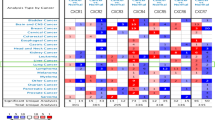Abstract
Purpose
To investigate the clinical significance of CX3 chemokine ligand 1(CX3CL1) and CX3CR1 in patients with bone metastasis from lung cancer. The expression levels of CX3CL1 and CX3CR1 mRNA and protein in primary lung cancer and lung cancer bone metastasis were detected by qRT-PCR and Western blot.
Methods
One hundred patients with lung cancer were divided into a boneless metastasis group (50 patients with bone metastasis) and a bone metastasis group (50 patients without distant metastasis). The bone transfer component was graded by Soloway classification (0 to III). The expression levels of serum CX3CL1–CX3CR1 axis were detected by enzyme-linked immunosorbent assay (ELISA). RT-qPCR and Western Blot were used to verify the transfection efficiency. The scratching assay was used to detect the migration of CX3CL1 to 95-D cells after down-regulating the expression of CX3CR1.
Results
The expression levels of CX3CL1 and CX3CR1 mRNA and protein in the primary lung cancer and lung cancer bone metastasis were significantly higher than those in the adjacent tissues (P < 0.0001). The levels of serum CX3CL1 and CX3CR1 in bone metastasis group were significantly higher than those in boneless metastasis group and healthy control group (P < 0.05). In the bone metastasis group, the levels of serum CX3CL1 and CX3CR1 were significantly positively correlated with the degree of disease progression (P < 0.01).
Conclusion
The expression level of serum CX3CL1–CX3CR1 axis is expected to be an auxiliary reference index for monitoring bone metastasis of lung cancer.





Similar content being viewed by others
References
Jiang W, Haque W, Verma V, et al. Stereotactic radiosurgery for brain metastasis from newly diagnosed small cell lung cancer: practice patterns and outcomes. Acta Oncol. 2019;58:491–8.
Imakita T, Matsumoto H, Hirano K, et al. Impact on prognosis of rebiopsy in advanced non-small cell patients with lung cancer after epidermal growth factor receptor-tyrosine kinase inhibitor treatment: a systematic review. BMC Cancer. 2019;19:105.
Akoury E, Ahangar P, Nour A, et al. Low-dose zoledronate for the treatment of bone metastasis secondary to prostate cancer. Cancer Cell Int. 2019;19:28.
Cazzato RL, Garnon J, Shaygi B, et al. Percutaneous consolidation of bone metastasis: strategies and techniques. Insights Imaging. 2019;10:14.
Fukai S, Okabe N, Mine H, et al. Garcin syndrome caused by sphenoid bone metastasis of lung cancer: a case study. World J Surg Oncol. 2018;16:46.
Zhang G, Liu Z, Chen Y, et al. High serum HDGF levels are predictive of bone metastasis and unfavorable prognosis in non-small cell lung cancer. Tohoku J Exp Med. 2017;242:101–8.
Li SL, Ma YY, Xiong Y, et al. Role of serum tumor markers in prognosis of operable non-small cell patients with lung cancer. Cancer Res Prev Treat. 2018;45:24–8.
Daamen LA, Groot VP, Heerkens HD, et al. Systematic review on the role of serum tumor markers in the detection of recurrent pancreatic cancer. HPB (Oxford). 2018;20:297–304.
Zhang Y, Zhao L, Wang X, et al. Repopulating retinal microglia restore endogenous organization and function under CX3CL1–CX3CR1 regulation. Sci Adv. 2018;4:eaap8492.
Liu P, Liang Y, Jiang L, et al. CX3CL1/fractalkine enhances prostate cancer spinal metastasis by activating the Src/FAK pathway. Int J Oncol. 2018;53:1544–56.
Liu W, Bian C, Liang Y, et al. CX3CL1: a potential chemokine widely involved in the process spinal metastasis. Oncotarget. 2017;8:15213–9.
Tsang JY, Ni YB, Chan SK, et al. CX3CL1 expression is associated with poor outcome in breast cancer. Breast Cancer Res Treat. 2013;140:495–504.
Schmall A, Al-Tamari HM, Herold S, et al. Macrophage and cancer cell cross-talk via CCR2 and CX3CR1 is a fundamental mechanism driving lung cancer. Am J Respir Crit Care Med. 2015;191:437.
Confavreux CB, Pialat JB, Bellière A, et al. Bone metastasis from lung cancer: a paradigm for multidisciplinary onco-rheumatology management. Joint Bone Spine. 2019;86:185–94.
Lang J, Zhao Q, He Y, et al. Bone turnover markers and novel biomarkers in lung cancer bone metastasis. Biomarkers. 2018;23:1–33.
Su YC, Chang H, Sun SJ, et al. Differential impact of CX3CL1 on lung cancer prognosis in smokers and non-smokers. Mol Carcinog. 2018;57:629–39.
Geismann C, Erhart W, Grohmann F, et al. TRAIL/NF-κB/CX3CL1 mediated onco-immuno crosstalk leading to TRAIL resistance of pancreatic cancer cell lines. Int J Mol Sci. 2018;19:1661.
Furio E, García-Fuster MJ, Redon J, et al. CX3CR1/CX3CL1 axis mediates platelet-leukocyte adhesion to arterial endothelium in younger patients with a history of idiopathic deep vein thrombosis. Thromb Haemost. 2018;118:562–71.
Author information
Authors and Affiliations
Contributions
YL, HM and TD are responsible for the conception or design of the work. YL, YY, LS and WW contribute the acquisition, analysis, or interpretation of data for the work. HM and YY provide the tissue samples. TD helps in the follow-up of the patients. LS helps in reviewing the histopathology slides. All authors finally approved the manuscript version to be published. YL is the guarantor of the article.
Corresponding author
Ethics declarations
Conflict of interest
The authors declare that they have no conflict of interest.
Ethical approval (Research involving human participants and/or animals)
The study was approved by Ethical Committee of The First Affiliated Hospital of Harbin Medical University and conducted in accordance with the ethical standards.
Informed consent
All study subjects signed informed consent prior to their participation.
Additional information
Publisher's Note
Springer Nature remains neutral with regard to jurisdictional claims in published maps and institutional affiliations.
Rights and permissions
About this article
Cite this article
Liu, Y., Ma, H., Dong, T. et al. Clinical significance of expression level of CX3CL1–CX3CR1 axis in bone metastasis of lung cancer. Clin Transl Oncol 23, 378–388 (2021). https://doi.org/10.1007/s12094-020-02431-6
Received:
Accepted:
Published:
Issue Date:
DOI: https://doi.org/10.1007/s12094-020-02431-6




